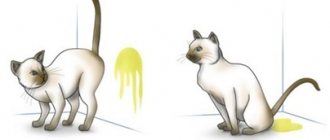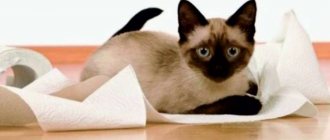Why is this happening
Leaving special marks should not be confused with normal urination. If in the second case the animal relieves itself naturally in a specially designated place (tray), then marking the territory is a special ritual with the help of which the fluffy wants to say that he is the owner here. As a rule, purrs choose any furniture, walls, interior or entrance door, flower pots, etc. for this purpose. Animals living outside leave “marks” on tree trunks, bushes, plants, and fences. Do not rush to scold a cat for bad behavior; he is guided by instincts, genetics and a self-preservation mechanism.
Representatives of the feline genus have an excellent sense of smell; the odors left behind serve as a clear, readable identifier of the individual. But it’s one thing when a cat marks territory, what if a cat does it? This also happens, although much less frequently; the female also leaves her “calling cards”, marking the boundaries of her zone, declaring who is in charge in the house. Animals, being under stress, strive to protect themselves from outside encroachment and imaginary enemies.
Why does a neutered cat continue to mark?
Reasons why a neutered pet does not stop marking:
- Habit. A castrated cat can continue to “play pranks” for several months after the operation, because a certain amount of hormones remain in the animal’s blood for some time, which push the pet to such actions. In this case, you need to be patient and wait a little.
- Wildness and experience of marks. If the animal is used to living on the street and was neutered at over a year of age, then the bad habit may persist for another 2-3 months after the operation. As the concentration of hormones in the blood decreases, the cat’s behavior normalizes and he stops marking.
- Cryptorchidism. It happens that an animal’s testicles develop incorrectly, and one of them does not descend into the scrotum. When performing castration, the doctor can only remove what is available to him. In this case, one testicle remains in the abdominal cavity, which provokes the appearance of marks after the operation. If a cat is diagnosed with cryptorchidism, then castration should not be carried out in the standard way, but using direct access - an incision in the abdominal cavity.
- Presence of other animals. Fear, jealousy, and switching attention to other pets can contribute to the appearance of marks in already neutered cats.
- Diseases of the urinary system. Cystitis, pyelonephritis, the presence of kidney stones - all these factors can provoke the resumption of a bad habit in a pet after surgery.
If there are several cats in the house, then the likelihood that the pet will continue to mark increases
Attention! If after castration you give your pet enough attention and show him your love and care, then the risk of resuming the harmful habit of releasing a stream of urine in the wrong place is reduced several times.
Reasons for marking territory after castration - video
When do the first cat marks appear?
For the first time, owners are faced with the problem of how to wean a cat from marking territory in the house after six months, by which time the fluffies become sexually mature. The onset of this period depends on the breed:
- large individuals (ragdoll, maine coon) - closer to 12 months;
- British - by 8 months;
- Siamese - by 5-6 months.
Personality, genetic predisposition, home environment, the presence of other pets and other factors matter. In some cases, you may be lucky and the question of how to wean a cat from marking will not become relevant. If the animal has a calm character, puberty occurs without incident, you may not see any odorous traces on interior items, doors or walls.
Choosing a tray and a place for it
There are several types of cat litter:
- An open box with sides is suitable for any type of filler. The higher the sides, the less filler there will be on the floor. Some pets like to intensively cover their tracks; in this case, it is advisable to purchase a design with high sides curved inward. No matter how hard the cat tries, the granules will not scatter across the floor.
- A box with a grid that can be used without filling or with a small amount of absorbent granules.
- A toilet in the form of a house, into which expensive filler (silica gel) must be poured.
It is important to choose the right location for the tray.
Cats are very sensitive to the process of defecation and want to do it in a secluded place. In addition, access to the toilet must be free, that is, the door must always be open. Placing a pot in the kitchen is unhygienic. Pets don't want to go to the toilet next to their food bowl. And for people, cat litter in the kitchen is an unpleasant sight.
The bathroom is also not very comfortable. For example, one of the family members decided to take a swim, but the cat wanted to go to the toilet. He won’t wait long; he’ll go check in somewhere in the hallway or under the sofa. It is best to place the tray in the toilet. To prevent the filler stuck to the pet’s paws from spreading throughout the rooms, a rug is placed underneath.
The quality and smell of the litter can also cause hostility in the cat. There are several types of fillers, each of which has its own advantages:
- absorbent sawdust granules are the cheapest option. The disadvantages are that they need to be changed frequently; spilled granules stick to the paws and tail, so they spread throughout the rooms;
- bentonite filler - also has several varieties: small, large, medium, with herbal aroma and odorless. The price of the litter is average, the disadvantages are the pet’s paws being smeared and white marks on the floor of the toilet;
- silica gel is the most convenient, but also quite expensive type of filler. It perfectly absorbs odor, does not smear the pet’s paws and holds urine well. It is poured in a layer of 3-5 cm and changed if the granules have changed their color. This type of filler is suitable for any type of tray.
There is another option, the most optimal for everyone: to teach the cat to go to the common toilet. For this purpose, special toilet pads are available for sale. The advantages are as follows:
- no tray needed;
- no need to buy filler;
- There is no need to clean the tray.
This all saves owners money and time. But not all animals can be toilet trained. There are stubborn animals that do not want to relieve themselves in a common toilet.
Among the disadvantages of sharing a toilet, it can be noted that in a large family in the morning there is not enough time for everyone, and then there is the cat doing his business.
How often do cats leave marks?
Here everything is individual, if females mark only during estrus, males can dirty the apartment all year round (usually in spring and autumn), causing significant inconvenience and discomfort to the owners.
On average, the frequency of leaving urine marks is about 2-3 per day, and “quiet periods” may be observed. But, unfortunately, it also happens that a purr marks at least 10 times in just one day. Here you need to decide what to do to prevent the cat from marking immediately.
Why do they do this?
Cats mark territory to “send a message,” which could be stress or readiness to mate. It is important to know that they are not doing this to harm anyone. This behavior is just related to smell, and it is different from normal urination because cats squat when they pee. But when they mark territory, they usually choose vertical surfaces as their “target”. They stand with their back to the object, twitch their tail, and, usually at the level of the other cat's nose, spray urine.
Fluffy marks things and shoes with urine
What should you do if your cat marks everywhere, including shoes and even clothes? Surely you were not prepared for such a development of events when you got a pet.
The fact is that the imperious purr does not care where his scent marks will be; the main goal is to inform competitors and surrounding people that there is no place for a stranger in this territory. As for shoes, they exude the aroma of human body and sweat. The animal will try in every way to drown out extraneous odors, replacing the aromatic bouquet of shoes that is unacceptable to it with urine marks.
Rules for arranging a toilet: choosing a tray
Many cats love trays with bars that don’t get their paws dirty. It is important to rinse this tray thoroughly after each time your pet goes to the toilet. The tray can be filled with special absorbent granules. Then daily cleaning after your pet will only include removing solid waste from the litter. The granules absorb moisture and odor well, but tend to stick to the paw pads or roll out over the sides of the tray during the process of instillation. To avoid litter spillage, choose a tray with high sides commensurate with the size of your cat. The pet should be comfortable using its toilet.
Animal marks a person
In certain cases, formed behavioral instincts force the cat to urinate on the owner. In this way, the purr declares its rights, making you a member of the imaginary cat clan. On the one hand, you should be proud that you are accepted as one of their own, on the other hand, this is unacceptable and everything must be done to stop the cat from marking the apartment and you.
It also happens that a cat perceives its owner as a competitor; this is especially typical for animals that were picked up on the street at puberty. Fuzzies, obeying natural instinct, continue to fight for themselves, mistaking you for a competitor.
There is only one reason for the marks - puberty
There is a big difference between the way cats mark and the way they just pee. Marking is an instinctive action. It is established by nature and controlled by sex hormones. It is impossible to wean a cat from marking, just like it is impossible to wean a cat from eating or breathing.
The desire to mark is an instinct tied to sexual hunting.
During puberty, that is, at approximately 7-8 months, the cat demonstrates its need to mate. For this reason, he can begin to mark not only walls with furniture, but also the things of the male owner. The fact is that cats distinguish the smell of human hormones and thus try to eliminate the smell of another male in the apartment in case there is a cat at home.
A cat can mark a person in order to show his love and the fact that the owner is now the property of the cat, so that other cats do not encroach on him.
Territory marking is provided by nature and is an integral part of cat instincts. In an apartment, the animal marks when a strange cat or at least the smell of a strange cat appears on the territory. When living in a private house, be prepared that your cat will “fight” with other cats for the front door and constantly mark it and the surfaces around it.
The owner should carefully observe the behavior of his pet and clearly understand when the cat marks, which shows natural instincts, and when it simply pees, which can mean a demonstration of character, anger, or resentment. Frequent urination can be a warning sign of health problems.
Best articles: TOP 16 deadly and poisonous fish on Earth
Where do cats mark most often?
Despite the strong, unpleasant aroma of cat urine, it is not easy to find the specific place where the little villain urinated. Typically, the crime scene is walls, cabinet fronts, furniture, a refrigerator, wallpaper, the owner’s clothes or shoes, or another pet’s sleeping place.
Some fluffies choose unusual, hard-to-reach places that a good sense of smell is not enough to identify. A UV lamp or flashlight with LED beams will help in the search; traces of urine are highlighted with a bright yellowish-neon spot.
Main reasons
In addition to the animal instinct to secure territory, there are other reasons for marking that are worth paying attention to.
Stress
Sometimes the smallest changes can cause stress in a cat, be it moving to another place of residence or new furniture. Marking the territory will again give him confidence that he is at home. Try to calm your pet at such moments with quiet conversation, stroking or playing. Marks may be a sign that the animal is not feeling well or is getting sick, you need to pay attention to this.
Frightened animal
They often mark the territory intensively due to the animal's fear. One of the residents of the apartment could have accidentally scared him. Also, the cause of fear could be the appearance of another animal in the house or some unusual situation. An experienced owner always senses this behavior of his pet and tries to calm him down using various methods.
Jealousy
This condition is an important reason for your pet to mark throughout the house. Oh, these cats are sensitive creatures and always feel a lack of attention to their person. The cat may be offended that the owner’s attention does not belong to him alone, for example, the appearance of a child in the house. Therefore, trying to attract attention to themselves, they begin to mark objects. Hold him in your arms, give him something tasty and pamper him. Perhaps he will stop continuing after this.
Mating
The marks mean that he is looking for a cat. In this case, you need to create a strong smell in those places that the cat fell in love with first. Apply ammonia, bleach, lemon, iodine or a solution of potassium permanganate to the areas it marks. Strong smells should scare the cat away.
You can make cotton swabs, dip them in the appropriate compounds and place them in certain places. Sometimes, in cases where the mating instinct is too strong, veterinarians prescribe special hormonal medications.
Prevention or how to stop a cat from marking in the house in advance
Uncastrated animals begin their “dirty deeds” no earlier than six months of age; until this period, living together with a kitten will not cause inconvenience. Problems begin after reaching sexual maturity, at which time the male’s leadership qualities begin to appear. Unfortunately, it is not possible to prevent the development of natural changes in the body.
At the same time, it is necessary to pay attention to the education of the animal:
- show your child who is boss in the house, do not allow permissiveness;
- pay attention to the fluffy, do not leave him alone for a long time;
- Make sure your cat has toys and play with him.
Do not use force against the cat under any circumstances, do not show aggression, do not throw objects at it, do not raise your voice. Harsh parenting methods will provoke an aggressive reaction, the purr will mark more diligently, thereby trying to protect itself. The only effective preventive measure is competent education and timely hygiene measures.
Tag prevention
Experienced breeders and veterinary specialists recommend to cat owners
the following measures to prevent cat marks:
- Castration is the most effective method of prevention, provided that the operation to remove the gonads is done before the onset of puberty.
- Education is a less effective method in the fight against marks. However, if the pet does not naturally have strong male leadership qualities, then proper education can play a key role in the prevention of cat marks.
- Permanent residence in the house of a person of the opposite sex. Having an unsterilized cat does not guarantee that the cat will stop marking its territory, and there is a big problem associated with offspring.
Unfortunately, there is no 100% method of preventing a cat from leaving marks. You can combat the natural manifestations of instinct in an uncastrated animal by resorting to educational and hygienic measures.
What to do if your cat marks
The peak of “activity” occurs in the autumn-autumn period, this is explained by hormonal changes in the cat’s body. Zoologists associate the strengthening of sexual instincts with an increase in the duration of daylight hours, as well as the peculiarities of the biological rhythm of the animal.
In search of an answer to the question of what to do to prevent a cat from marking, owners are trying non-standard solutions. One of these can be called keeping an animal during an “exacerbation” in a darkened room. If the “irreparable” has already happened, it is necessary to clean the stained area, thoroughly wash the furniture and walls, apply a disinfectant and repellent spray.
Veterinarians do not recommend using detergents containing bleach; bleach vapors are dangerous for people and animals. Regular baking soda, a weak solution of vinegar, or special products that neutralize the pungent odor of urine will do.
At worst, if you don’t have a special spray on hand, you can use aromatic oils, eau de toilette, incense sticks, perfume or air freshener.
Age characteristics of cats
When people get a kitten, they rarely appreciate the full depth of the problem. Having matured, he will probably begin to mark the home where he lives. Small kittens do not cause as many problems for their owner as adult cats. They often go to the litter box and leave a trail of unpleasant odor throughout the apartment. Over time, cat instincts come to him, which are inherent in nature.
One of these instincts is a sense of ownership. This instinct is absolutely normal, because all cats are predators in the wild. When cats live in the wild, they can catch mice, and at home, wild instincts manifest themselves in stripping furniture in anticipation of a good hunt.
The moment when it begins to mark housing is a sign that the animal has reached maturity. And as you grow older, the number of pheromones increases, and such a pungent smell appears. Cat breeds begin marking territory at different ages, but on average this process occurs at 6-7 months.
How to remove traces of urine in an apartment
Even when you have decided what to do to prevent the cat from marking the house, you need to be prepared that the chosen measures may not give immediate results. Be patient, remember that the cat does nothing to spite you, he is guided by natural instincts that cannot be resisted.
List of what you will need in the fight for cleanliness in the house:
- detergents;
- sprays and liquids for cleaning carpets;
- odor neutralizers that wean the animal off marks.
Of course, you can use more affordable means - vinegar solution, hydrogen peroxide, citric acid, but their effectiveness is much lower, and besides, you risk ruining the upholstery of an expensive sofa.
Difference between marks and normal urination
Wet spots are a tricky subject, they may or may not be a mark. We figured out the subtleties of distinguishing a puddle of urine from a “trace”. And the research results were presented in a convenient comparative table. Now you will definitely understand what is what.
| Label | Puddle | |
| Volume | Small, small and frequent spots | Big, one continuous spot |
| Character of the jet | Short, sharp, like from a spray gun | Calm, long, continuous (in a healthy animal) |
| Smell | More sharp and caustic | Less harsh, not as corrosive |
| Location | More affordable and easy to get to | Less exposed, secluded and comfortable |
| Animal pose | Raises his tail and shakes it. | Sits down, lowers his tail |
| Animal behavior | Doesn’t bury, “puffs” demonstratively | Hiding, carefully burying |
Difference between a mark and a puddle
What to do to prevent a cat from marking - use folk remedies
As you know, folk “proven” methods exist in solving any issue; weaning a cat from a bad habit is no exception. Some owners use the scent of citrus to influence their pet's behavior; for others, the most common laundry soap helps.
Try treating the cat's favorite places with ammonia, put wormwood or a bag of aromatic spices there, turmeric, mustard powder, red and black pepper will do. Fluffies do not like substances that emit a pungent odor, so with a high degree of probability, they will avoid this place, or simply find a new one, depending on their luck.
Outputting marks
The cat is attracted to his own marks on wallpaper, furniture and other things. To discourage him from these marks, it is necessary to eliminate the smell. You can wash the area with a disinfectant, and then place orange or lemon peels in this corner, or sprinkle ground black, red, or allspice. Vinegar does not eliminate the odor, but, on the contrary, enhances it, so it is not advisable to wash marks with water and vinegar.
The pet store recommends purchasing a repellent spray. This product is sprayed on the places that the pet has chosen for marks. There is another aerosol - to attract animals. Its purpose is to teach the cat to go to the toilet. Therefore, when purchasing, it is important not to confuse the names of the sprays.
Another trick to scare a cat away from corners: stick double-sided tape on the floor around your pet’s favorite places to visit. Sticky areas frighten the animal, and it tries not to approach them.
Food and toilet for a pet are incompatible concepts. You can use one more trick. A bowl of food should be placed in the unfortunate corner with the marks. The pet won’t even think about shitting there anymore, because food is much more important than any principles.
We correct the cat's behavior with special means
Cats often cause mischief in the house due to an unstable emotional state, which can be caused by moving, the appearance of a new pet, frequent quarrels, the birth of a child, and other factors. In this case, you need to help the cat survive stress with the help of sedatives.
It is advisable to choose plant-based homeopathic remedies that do not have a sedative effect. Regarding the use of hormonal contraceptives, their effectiveness has not been proven in the fight against feline marking in the home.
Jealousy
This is true for our pets no less than for people. They are great owners, and they do not want to share their owner, as well as their home, with strangers. Therefore, the arrival of a new member of the household is often painfully perceived. If your pet has always been disciplined (especially if he has already been neutered), and now he has started marking the house, then perhaps this is his way of letting the new family member know who is boss. This may also apply to the situation of protracted repairs, when builders appear at home every day to perform various works.
Sometimes even an ordinary guest visit can cause an animal to be jealous. Especially if he sees that the owner has turned all his attention to the guest, and he was asked to leave. Today, veterinarians say that cats can even be jealous of gadgets when they see that their beloved owner spends all his time only on a computer or tablet. Again, the best way to solve this problem is to allocate your free time and attention wisely. If you have a pet, then you need to pay enough attention to it.
How to stop a cat from marking the door
Quite often, purrs begin to mark their territory immediately upon entering the house, that is, they leave drops of urine on the front door. To discourage your pet from damaging the door leaf, thoroughly wash the surface, remove the unpleasant odor, and apply a product with a cat-repellent scent.
Additionally, you can scatter strong-smelling spices near the mat, put a slice of lemon, or leave a cotton swab dipped in ammonia.
What do cat marks look like?
Cat marks usually look like puddles, drips or splashes. If the animal has marked walls or vertical objects, the owner will find marks in the form of splashes and drips. Cats leave puddles if they mark carpets, rugs, or urinate on the floor. On a light wall or soft upholstery, the mark will have a yellowish tint. It is more difficult to detect urine on a dark surface, such as carpet.
What to do if other people's cats are marking your territory
If your local area is regularly attacked by yard cats, each of whom considers it their duty to mark it, you can install an ultrasonic repeller near the house.
A special device produces sounds that are harmless to humans and animals and repel uninvited guests. Please note that this solution is suitable for those who do not have their own pets, otherwise your cat will also experience discomfort.
Weaning off marking of a young pet
If you have adopted a young cat into your home, you need to be patient. Think in advance about how to train it and how to deal with it if marks do appear. Until they mature at the age of 6-7 months, kittens do not mark their apartments. Therefore, watch carefully when such signs begin to appear. It is problematic to completely get rid of the marks, but you can teach the purr to behave properly.
Pay a lot of attention to the maturing cat - young ones always feel a lack of attention and may begin to mark precisely for this reason. If you leave the apartment for a long time and leave the animal alone, do not forget to leave him toys and enough food. Treat it kindly, the use of various forceful methods does not make the situation easier and the cat will take on its own even more strongly.
If the cat marks the territory near the house
You already know what to do when a cat marks in the apartment, it’s time to figure out what to do with a pest that regularly does “dirty things” on the street.
The solution should be comprehensive, try to redirect the pet’s attention, use a standard set of repellents.
For distraction you can:
- install a gaming complex;
- buy a new toy;
- use veterinary drugs to correct behavior.
Organizing a place to relieve yourself outdoors can also help. If you need to use a special tray for your home, you can organize a sandy mound in the fresh air, planting aromatic grass around it that is attractive to cats.
Why do cats mark objects in the house?
Cats begin to mark their territory due to the influence of various irritating factors. Unlike cats, they do this much less often, so the owner may confuse the marking process with urination. The list of main reasons is as follows:
During illness, the pet can relieve itself outside the tray. The problem arises mainly due to the formation of kidney stones and the development of cystitis. The animal, on a subconscious level, gets the impression that the pain is manifested precisely because of the tray, so it looks for other places of fusion of need. The situation can be corrected, but to do this, the pet must be shown to a veterinarian. Otherwise, the disease will progress. Representatives of the cat family may mark their territory due to the arrival of a new person or another animal in the house. The pet will perceive such an update as a threat to its territory. The main instinct will advise him to mark objects, showing who is in charge in the house. If the problem is the arrival of a new family member, then only time will help. The cat must get used to the person in order to “accept” him. When getting another pet, you need to be prepared to share the house between them. Otherwise, there will be little chance of avoiding conflict. Sometimes a pet begins to mark objects as a result of another animal marking the front door. The owner will have to get rid of the foreign smell and try to prevent the situation from recurring.
There have been cases when a cat began to mark corners in the house after moving. For her, the new environment has not yet been explored, so instincts are triggered. Over time, everything returns to normal. After sterilization, the cat marks in the apartment due to the stress it has experienced. There is no need to scold her, since time must pass for the animal’s psyche to recover. In severe cases, you may want to consult with your veterinarian about giving a sedative medication to calm your pet's nervous system. A cat may mark its territory due to raging hormones. After reaching 7-8 months, it becomes a sexually mature individual. If a cat lives in the neighborhood, the female begins to mark the corners of the house, showing the boundaries of her possessions. The whole problem here is the activation of instincts, since against the backdrop of hormonal surges there is a fear of losing territory. Sterilization does not actually help in this situation. The animal returns to normal and continues to mark. The only salvation will be to get rid of the potential sexual partner, at least for the duration of the heat. There are situations when a cat has to be left with strangers. She begins to mark her territory as a sign of protest or simply due to stress. The animal’s behavior returns to normal only after returning to its familiar environment.
shutterstock
If cats shit in the entrance
If the marks left in the apartment cause inconvenience only to the owners, an unpleasant smell in the front door is a collective problem, affecting all residents. To eradicate the problem, it is necessary to castrate all males who live in nearby areas.
The solution will kill several birds with one stone - you will prevent the growth of the population of stray animals, solve the issue of unpleasant odor, and get rid of cats meowing under the windows. Install a door with a locking lock at the entrance to prevent uninvited guests from entering. Otherwise, the solution is standard - thorough cleaning, treating surfaces with repellents and sprays to neutralize odors.
How to get rid of the unpleasant smell of tags in the apartment
To get rid of the unpleasant smell of cat marks, you need to thoroughly wash the area where the cat has acted. Then let it dry and apply a special spray, which can be purchased at a pet store. Some of the most effective are Hygiene, “Stain, Mark and Odor Eliminator for Cats” and others. These sprays should be sprayed immediately after wet cleaning, before the cat marks again.
Spray "Stain, Mark and Odor Eliminator" effectively removes cat urine
To eliminate unpleasant odors, you can try tar soap, which has a bright woody aroma. It is best to use a liquid version, which can be easily applied to a dirty surface. The soap should be left until completely dry, and then take a damp sponge and wipe off. If necessary, you can repeat the procedure.
Tar soap has a pleasant woody aroma and helps remove cat marks.
Another folk remedy that allows you to get rid of the effects of cat marks is lemon juice, which should be used in concentrated form. Using a cotton pad, apply the liquid to the contaminated surface. However, it is important to thoroughly rinse the area with bleach first. Otherwise, the smell of urine will persist for a long time.
Lemon juice helps remove the smell of cat marks
In addition, many cat owners use a bite that effectively deals with the smell of cat urine. This product should only be used after thorough cleaning. The bite should be applied to the entire marked surface. The procedure should also be repeated the next day. Instead of vinegar, hydrogen peroxide also does an excellent job, which can be used to treat almost any surface.
Vinegar helps eliminate cat urine odor
Cat urine has a strong odor that is not easy to get rid of, so it is recommended to use several products at once.
How to get rid of the smell of cat urine - video
What to do depending on the reasons
It is necessary to get rid of the problem based on the reasons, namely:
- Desire to reproduce. If a cat wants to mate, he marks to attract females. You should use available means. It is necessary to wipe the areas with vinegar, lemon, ammonia, bleach, potassium permanganate or iodine. You can also soak cotton pads or swabs with these products and then place them on the marked areas. They are good at scaring away animals, but only until they have a strong smell. You can also purchase professional products. It is important that protein foods predominate in the diet.
- Feeling of fear, pain. If a pet is afraid of something, it marks in order to feel comfortable. It is necessary to understand why the cat is afraid: the appearance of a new object or the appearance of a living creature. It is then recommended to eliminate the cause. You also need to distract your pet by devoting more time to it: playing with it, buying it a new toy or treats.
Perhaps the cat is in pain, which is why he is so diligent in attracting attention to himself. Here you will need specialized help from a veterinarian.
- Jealousy . The reason may be guests who came with their pet. This can also happen if a new pet has appeared in the family. The cat shows that he doesn’t like this and tries to attract attention and marks the place, showing the discomfort of this situation. To do this, you need to pay more attention to the cat: play with him, scratch him behind the ear, etc.
- Boredom . Often the owners are very busy and do not pay attention to the animal’s hints, so it moves on to a more effective method – tagging. A characteristic feature of this reason is the tagging of the owner’s personal belongings. To do this, you need to pamper your pet with something tasty, buy a toy, and take him in your arms.
- Defense of the territory . This is the most difficult option, since measures here are quite difficult to take. This may start due to a rearrangement in the house, and he will not like it. Also due to the birth of a child. The reason could be an ordinary neighbor who smelled like another cat. Therefore, he wants to mark everything in order to show who is in charge in this territory. This is typical for very capricious and arrogant pets, who show who keeps the apartment in order. Among the effective methods is the imitation of hissing, snorting, and paw strikes, which resemble a fight with an opponent. But it’s not a fact that this will help.
Raising an adult cat
There will be more problems with an adult cat, since they are trying to mark the territory very actively. This is especially evident during the period of sex hormones - in summer and spring. At this time of year, the amount of hormones in the animal rises, which promotes the activation of marking of territory and objects.
It is recommended to keep your pet in a slightly darkened room with curtains, as bright light stimulates the production of sex hormones. To reduce the appearance of new marks, immediately disinfect those already made with hydrogen peroxide or other means. Do not use solutions containing chlorine to avoid harm to the animal. After treating the area, you can use oils with an aromatic effect: orange, lavender, rosemary.
How cats mark territory
Cats are territorial animals. By marking the boundaries of their property with their scent, they make it clear to everyone: they do not want to share this very territory with anyone.
An interesting point: any thing can become the object of a mark. Toys, furniture, a door frame, a place to sleep, even the owner - nothing will be left without a “trace” if the cat considers itself a full-fledged owner.
When many people hear the word mark, they only remember the most problematic way for mustachioed and striped creatures to defend their space. That is, about odorous, wet marks left on walls, furniture, doors or favorite things of bipeds. But this is not the only option. In addition to stinking puddles, claws, teeth, and the so touching “rubbing” of the owners on any suitable surface and place are used. For example, on the lid of a laptop or the leg of a roommate giving food.
My master, completely and completely.
Cats' scent glands secrete pheromones - signal substances that can tell a lot about the animal. Age, gender, status, mood. And of course, their habitat. These glands are located on the face (around the eyes, on the chin, behind the ears), at the base of the tail and between the pads of the paws.
This is interesting: by caressing your arm or writing figure eights between your legs, the cat is not so much trying to show affection as leaving its imprint on you. But most people don't know about it











